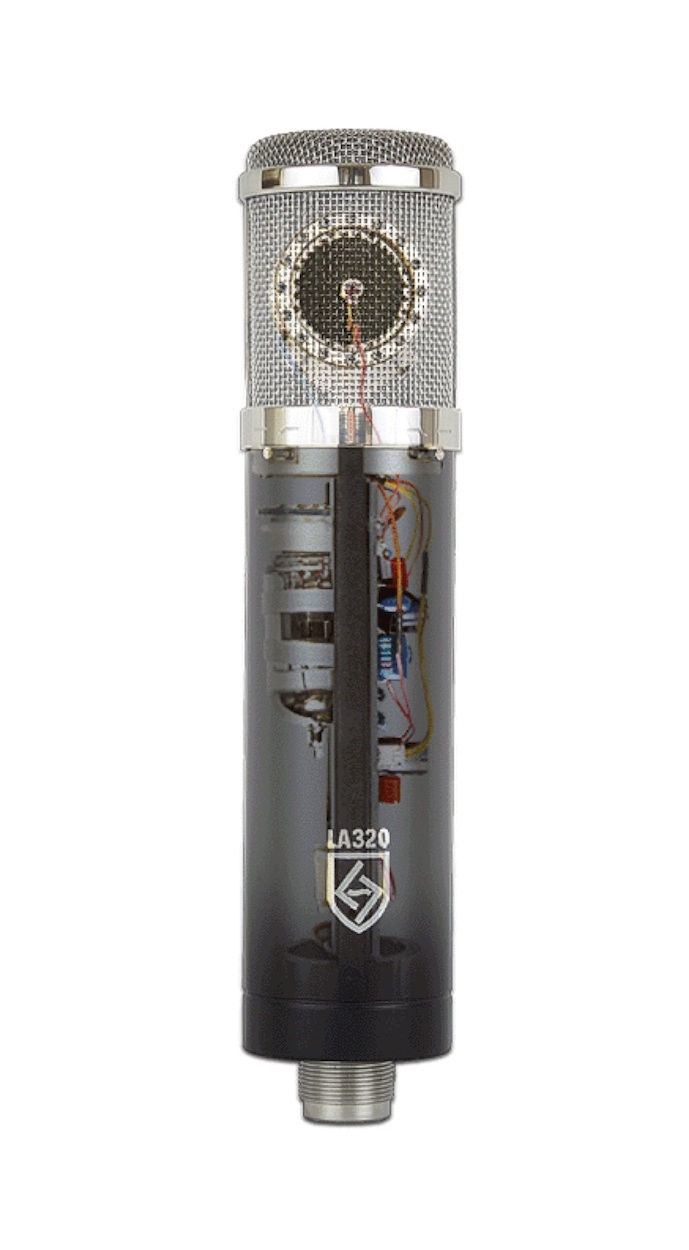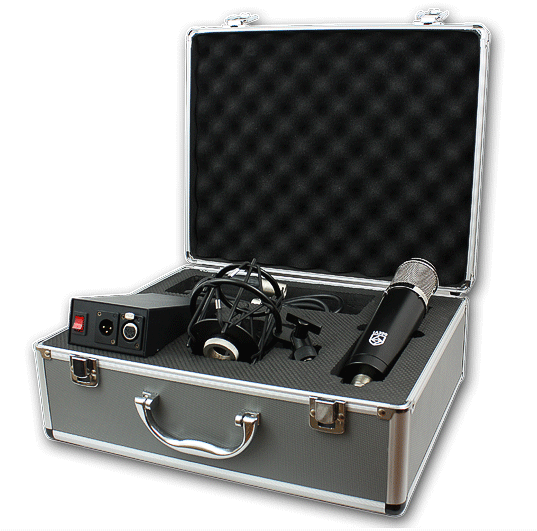New Gear Review: Lauten Audio Series Black LA-320 Large Diaphragm Condenser Microphone

The LA-320 is an entry level tube condenser mic that aims to deliver results comparable to microphones three times its price.
Are you looking to upgrade your bedroom microphone setup? Or, maybe you’ve got a small professional tracking room in need of an additional tube microphone to round out your locker? Are you looking for something with a balanced, neutral response that will sound great in most situations? Perhaps the new Series Black LA-320 by Lauten Audio will fit the bill. I put it through its paces to find out.
The Lauten Audio Series Black LA-320 is advertised as an entry-level fixed cardioid large diaphragm condenser microphone. It features a 1″ gold sputtered diaphragm, dual-triode vacuum tube, 120Hz low-cut filter, 12kHz high-cut filter, and a transformer balanced output for the “budding engineer” who is “ready to let the Series Black LA-320 lead the way into that vintage vacuum tube tone you’ve heard all about,” as Lauten proudly proclaims on the LA-320’s product page.
Let’s be real: High quality analog circuitry is expensive, so I wasn’t holding my breath and hoping to get a U47 at 1/30th of the price. Regardless, I was still pretty pumped to get a pair of these in my hands to see what they could do.
Features
The LA-320 comes in a traditional-yet-modern-looking aluminum trimmed latching hard shell case. Inside the case, the microphone, PSU, 2-piece elastic shock mount, 5–pin to XLR and IEC cables all sit inside their own cutouts, and fit without feeling like you’re going to break something or that anything will come loose. The black, matte-finished microphone itself felt light, but not cheap. As someone with a very low tolerance for poor-quality shock mounts, I thought the mic fit snugly and securely in its mount and found that it was easily positioned into place.
In Use
Before I was able to get the LA-320s in the studio I was asked to record some on-location podcasts. Though is not my normal thing, I thought: “Hey, I’ve got a pair of tube condensers handy, so let’s do this.”
Looking at the frequency response in the material provided, you can clearly see that the LA-320 is designed to have a fairly even response. It doesn’t look like it’s voiced to be “present” in the upper midrange like many tube mices, since there’s a actually a slight dip from 3-5kHz. There’s also a bump at 8-10kHz, so I was curious how they would handle conversational voice in a non-traditional recording environment.
I was immediately struck by how natural and open the pair of LA-320s sounded on the interviewer and interviewee. They also seemed to have pretty good off-axis rejection, but I still didn’t have too much context to evaluate.

Take your LA-320 on-the-go, safely. The included aluminum case features snug-fitting cutouts for the microphone, PSU, shock mount, and 5–pin to XLR and IEC cables.
Back in the studio, I put the LA-320 (and sometimes two LA-320’s) to work in about 20 sessions over the course of two months. Instead of me just telling you what I think of the mic and leaving you to wonder if I even know what I’m talking about, below are some unprocessed examples of it in use for you to make your own decisions. The mic preamps were always one of the API 1608’s on-board 312-esque pres.
Because I was not familiar with the mics, and was throwing them into an actual session for the first real use, I used the pair as an extra set of drum room mics in a normally bright, dry-walled, medium-to-large size live room. Because the LA-320 has a low-pass filter at 12kHz, I was able to cut the brightness down at the mic instead of using EQ. That would probably be helpful if you don’t have an outboard EQ to pop in.
Here is a clip of an XY pair over the drums with no filters engaged:
The flatter response of the LA-320 lends itself to a more open, neutral sound. This can make it a bit more challenging to get a present sound on close mic’d instruments that tend to feature between 1-5kHz as the LA-320 actually has a slight dip between 3-5kHz. Listen below to a comparison between the LA-320 and a slightly more expensive multi-pattern Sterling ST69 ($599 street price).

Using an archtop guitar for soling and strummed chords, I created another comparison between the LA-320 and Sterling ST69 through a re-amped Fender Twin.
(This performance was captured via a Radial JDI while tracking. Later, the DI signal was sent back through a Radial reamp box to the amp. The mic preamp gain was calibrated with white noise and a 1kHz sine wave through a Fender Twin before reamping.)
Even though the ST69 has some nice thickness around 125Hz, I like the midrange sparkle of the LA-320. Most of the time in a reasonably dense mix, you’re going to need to sacrifice the 125Hz before you’ll want to boost mids, anyway.

Here we have the LA-320 against a Neumann TLM49 ($1699.95 street price) on vocals. Do you hear 3x more value in performance?

To Be Critical
As promised, the mic performed well, even when directly compared against mics costing significantly more. In my examples, the LA-320 leans a little brighter than its competition due to its relatively slight rise from 8-10kHz. The LA-320 also sounded a little clearer, though perhaps slightly more “two-dimensional” than the other two, pricier mics, to my ear. You are probably not going catch a “vibe” from the LA-320 because of its mostly flat response in the midrange and its slight dip between 3-5kHz. However, if your sound source is balanced, the LA-320 will capture it as such.
Summing it Up
While the fixed polar pattern is definitely a drawback (although unsurprising at this price point), and I would have preferred a lower roll-off frequency, the LA-320 sounded pretty great in almost all the situations I used it on.
When compared with not only mics in its price class but those a tier or two higher, I found the differences to be minimal. While the LA-320 doesn’t quite deliver on that common, tightly-held idea that tubes will give you mojo, it will do a very nice job of capturing what’s there.
Is this the only mic you’ll ever need? No. But at a $499 price point, I doubt you’ll ever regret the purchase.
Please note: When you buy products through links on this page, we may earn an affiliate commission.






